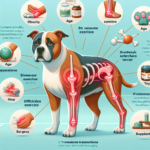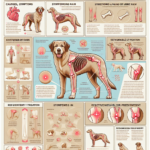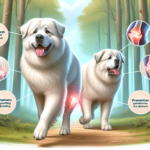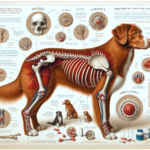Grand Basset Griffon Vendéen Joint Pain: Causes, Symptoms, Prevention, and Treatment
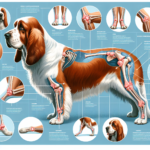
Introduction
The Grand Basset Griffon Vendéen (GBGV) is a charming and energetic breed known for its distinctive appearance and lively personality. Originating from the Vendée region of France, this breed was developed for hunting small game, particularly rabbits and hares. With its long, low body, rough coat, and expressive eyes, the GBGV is both a capable hunter and a delightful companion. Despite its robust nature, the breed is prone to certain health issues, including joint pain, which can significantly impact its quality of life.
General Health Concerns
Like many purebred dogs, the GBGV is susceptible to a range of health problems. Common issues include ear infections, due to their long ears, and eye problems. However, one of the most significant concerns for this breed is joint pain, which can arise from various conditions such as hip dysplasia, arthritis, and elbow dysplasia.
Importance of Joint Health in Grand Basset Griffon Vendéen
Joint health is crucial for the GBGV, given its active lifestyle and hunting background. Healthy joints are essential for maintaining mobility, comfort, and overall well-being. Joint pain can severely limit the dog’s ability to engage in physical activities, leading to a decline in both physical and mental health. Therefore, understanding the causes, symptoms, prevention, and treatment of joint pain in this breed is vital for owners.
Breed-Specific Joint Pain Risks
Genetic Predisposition
The GBGV has a genetic predisposition to several joint-related issues. Hip dysplasia, a condition where the hip joint doesn’t fit properly into the hip socket, is relatively common in this breed. This can lead to arthritis and significant pain over time. Elbow dysplasia, another genetic condition, affects the elbow joint and can cause lameness and discomfort. These genetic factors make it essential for breeders to screen for these conditions to reduce their prevalence.
Age-Related Risks
As the GBGV ages, the risk of developing joint pain increases. Older dogs are more prone to arthritis, a degenerative joint disease that causes inflammation and pain. For the GBGV, signs of joint pain may start appearing as early as middle age, around 5-7 years old. Regular veterinary check-ups are crucial during these years to monitor joint health and catch any issues early.
Activity Level and Joint Stress
The GBGV is an active breed that requires regular exercise to stay healthy and happy. However, their high activity level can also contribute to joint stress, especially if they engage in high-impact activities like jumping or running on hard surfaces. While exercise is essential, it’s important to balance it with activities that are gentle on the joints to prevent long-term damage.
Common Symptoms of Joint Pain in Grand Basset Griffon Vendéen
General Symptoms
- Limping: One of the most noticeable signs of joint pain is limping or favoring one leg over the other.
- Stiffness: Dogs with joint pain may show stiffness, especially after resting or sleeping.
- Reluctance to Move: A dog in pain may be hesitant to engage in activities they once enjoyed, such as running or climbing stairs.
- Swelling: In some cases, the affected joint may appear swollen or feel warm to the touch.
- Behavioral Changes: Irritability, lethargy, or changes in appetite can also indicate joint pain.
Breed-Specific Symptoms
For the GBGV, specific symptoms may include a noticeable decrease in their usual playful and energetic behavior. Given their hunting background, a reluctance to engage in tracking or chasing activities can be a significant indicator of joint pain. Additionally, due to their long, low body structure, they may show signs of back pain, which can be related to joint issues.
When to Consult a Vet
If you notice any of the above symptoms in your GBGV, it’s important to consult a veterinarian promptly. Early intervention can prevent further deterioration and improve your dog’s quality of life. Persistent limping, significant behavioral changes, or visible swelling should be addressed immediately.
Preventive Measures for Joint Health
Exercise Recommendations
Regular, moderate exercise is key to maintaining joint health in the GBGV. Activities such as walking, swimming, and gentle play are excellent choices. Avoid high-impact exercises like jumping or running on hard surfaces, which can exacerbate joint stress. Consistent, low-impact exercise helps keep the joints flexible and muscles strong, supporting overall joint health.
Dietary Suggestions
A balanced diet rich in essential nutrients is crucial for joint health. Foods containing glucosamine and chondroitin can support joint function and repair. Omega-3 fatty acids, found in fish oil, have anti-inflammatory properties that can help reduce joint pain. Consult your veterinarian for specific dietary recommendations and consider supplements if necessary.
Weight Management
Maintaining a healthy weight is vital for reducing joint stress. Excess weight puts additional pressure on the joints, exacerbating pain and potentially leading to further damage. Regularly monitor your dog’s weight and adjust their diet and exercise routine as needed to keep them within a healthy range.
Early Screening and Monitoring
Early screening for joint issues can help catch problems before they become severe. Regular veterinary check-ups should include joint assessments, especially as your GBGV ages. Genetic testing for conditions like hip and elbow dysplasia can also be beneficial, particularly if you plan to breed your dog.
Treatment Options for Joint Pain
Non-Surgical Treatments
Non-surgical treatments are often the first line of defense against joint pain. These can include:
- Medications: Anti-inflammatory drugs and pain relievers can help manage symptoms.
- Physical Therapy: Exercises and treatments designed to improve joint function and reduce pain.
- Lifestyle Adjustments: Modifying your dog’s activity level and environment to reduce joint stress.
Surgical Options
If non-surgical treatments are ineffective, surgical intervention may be necessary. Common surgeries for joint pain include:
- Hip Replacement: Replacing the damaged hip joint with an artificial one.
- Arthroscopy: A minimally invasive procedure to clean out the joint and remove damaged tissue.
- Joint Fusion: Fusing the bones in a joint to reduce pain and improve stability.
Alternative Therapies
Alternative therapies can complement traditional treatments and provide additional relief. These may include:
- Acupuncture: Using needles to stimulate specific points on the body to relieve pain.
- Hydrotherapy: Water-based exercises that reduce joint stress while improving strength and flexibility.
- Massage: Gentle massage can help reduce muscle tension and improve circulation around the joints.
Lifestyle and Management Tips
Daily Care Routine
A consistent daily care routine can help manage joint pain in your GBGV. This might include:
- Regular, gentle exercise such as walking or swimming.
- A balanced diet with joint-supporting nutrients.
- Administering any prescribed medications or supplements.
- Monitoring your dog’s weight and adjusting their diet as needed.
Modifying the Home Environment
Making your home more comfortable for a dog with joint pain can significantly improve their quality of life. Consider the following modifications:
- Ramps: Use ramps instead of stairs to reduce joint stress.
- Orthopedic Beds: Provide a supportive bed to alleviate pressure on the joints.
- Non-Slip Flooring: Ensure your floors are non-slip to prevent falls and injuries.
Long-Term Management
Long-term management of joint pain involves ongoing care and monitoring. Regular veterinary check-ups, consistent exercise, and a healthy diet are essential. Additionally, staying informed about new treatments and therapies can help you provide the best care for your GBGV.
FAQs About Grand Basset Griffon Vendéen and Joint Pain
What are the early signs of joint pain in a GBGV?
Early signs include limping, stiffness, reluctance to move, and behavioral changes such as irritability or lethargy.
Can joint pain in GBGVs be prevented?
While genetic predispositions can’t be entirely prevented, maintaining a healthy weight, providing regular exercise, and a balanced diet can significantly reduce the risk of joint pain.
Are there specific exercises that are better for GBGVs with joint pain?
Yes, low-impact exercises like walking and swimming are ideal as they help maintain mobility without putting excessive stress on the joints.
What dietary supplements can help with joint health in GBGVs?
Supplements containing glucosamine, chondroitin, and omega-3 fatty acids can support joint health and reduce inflammation.
When should I consider surgery for my GBGV’s joint pain?
Surgery should be considered if non-surgical treatments are ineffective and your dog’s quality of life is significantly impacted by joint pain.
Conclusion
Joint pain is a significant concern for the Grand Basset Griffon Vendéen, but with proper care and attention, it can be managed effectively. By understanding the causes, symptoms, prevention, and treatment options, owners can ensure their GBGV remains active and comfortable throughout their life. Regular veterinary check-ups, a balanced diet, appropriate exercise, and a supportive home environment are key to maintaining joint health. Always consult your veterinarian for personalized advice and treatment plans to keep your GBGV happy and healthy.

